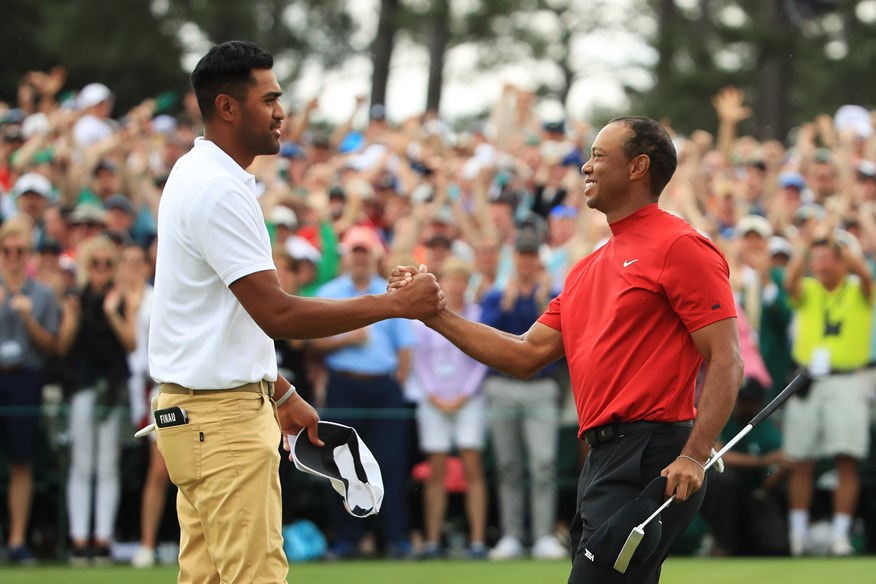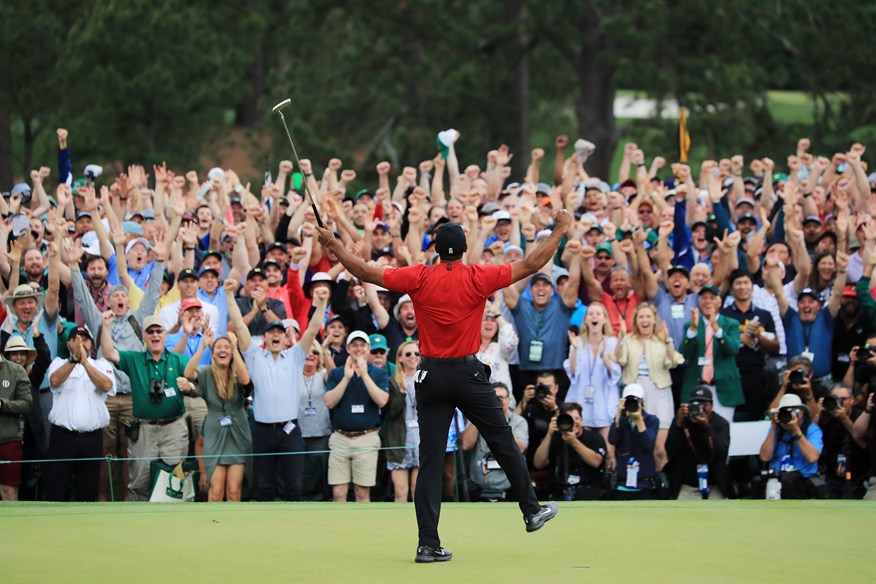How Tiger Woods changed the game of golf
Last updated:
How did Tiger Woods change the game of golf? It’s everywhere you look
The way Tiger Woods has changed golf is evident every time you turn on the TV, go to a tournament or read an article: the youth and athleticism of the players, the prize funds, the length of the courses – it’s all a result of the impact Tiger has had on the sport.
Woods effectively beat out a leaderboard full of players who are only in the game because they were inspired by him on Sunday as he claimed his 15th major title at the Masters.
It was a feat that seemed unfathomable just under two years ago when he withdrew from the Masters to have a fourth back surgery. It resulted in a fused spine, and he was left doubting whether he’d ever return to the game.
“I don’t know what the future holds for me,” Woods had said in September 2017 at the Presidents Cup. It followed a decade of injury problems, personal scandals and no major titles, and there was a feeling it was the end of an era. At his worst, before the final surgery, Woods could barely move without pain.
“There’s really nothing I can look forward to, nothing I can build towards,” he had said in 2015. “It’s literally just day by day and week by week and time by time. Where is the light at the end of the tunnel? I don’t know.”
Yet there he was on the 18th green being helped back in to his green jacket for a fifth time by Patrick Reed – a man who wore black and red on a Sunday exclusively for a long time simply because his idol did.

“The best player ever to live when I was growing up wore black pants, a red shirt,” Reed told The Augusta Chronicle in 2018. “I was growing up watching him. I always thought, you know, it would be cool to wear black and red on Sunday.”
Nike’s new policy means Reed no longer gets to wear those colours on a Sunday, but none-the-less it seemed a fitting tribute to the man who achieved the biggest comeback in sports history.
From 1997, when he won his first major as a 21 year old, Tiger has been a dominant force in the game. When he came out on Tour he was unlike anyone else out there: He was young, supremely athletic and hit the ball for miles.
Since his debut he’s broken almost every record there is, and changed the face of golf to an unregonisable entity. Players now turn Pro as teenagers, courses have been ‘Tiger proofed’, prize funds increased, and as he quipped in his post-victory press conference, even Phil Mickelson is in the gym these days.
Here, we assess four ways Tiger Woods has changed the game of golf over the past two decades.
In the gym: The athletism of players
Almost every player out on Tour right now is an athlete: They don’t just spend time practicing their games, but dedicate a lot of time to physically preparing themselves in the gym. You only need to look at Brooks Koepka and Dustin Johnson to see that the best players in the world are not just golfers now, but athletes. When we interviewed Dustin Johnson in a recent issue of TG, there was a page dedicated to his workouts and how they help his game.
But when Tiger Woods was picking up major titles at an impressive rate at the turn of the century, he was a one-off. Golf had always been chided for ‘not being a sport’, but Tiger Woods changed what it meant to physically play the game of golf, and revealed an exercise regime that will you leave you tired simply after reading.
“I used to get up in the morning, run four miles,” Woods said of his old regime. “Then I’d go to the gym, do my lifts. Then I’d hit balls for two to three hours, I’d go play, come back, work on my short game. I’d go run another four more miles, and then if anyone wanted to play basketball or tennis, I would go play basketball or tennis. That was a daily routine.”
At 43 and a lot of surgeries down the line, his body no longer allows that kind of exercise, but the legacy of his physicality has transformed how every other player works on their bodies. And Tiger is very much aware of it.
“I think that I’ve driven a lot more youth to the game,” Tiger said in his press conference after his Masters victory. “You know, a lot of the guys that are ‑ especially on the Tour now, are training. They are getting bigger, stronger, faster, more athletic. They are recovering better. They are hitting the ball prodigious distances, and a little bit of that’s probably attributed to what I did.
“When I first turned pro, I was the only one in the gym, except Vijay [Singh]. So it was just basically he and I for years, and now everyone trains. Everyone works on their bodies, besides their game, and hey, even Phil [Mickelson] is working out! Things have come a long way.”
Influencing the next generation
Tiger Woods turned pro in August 1996 when he was just 20 years old, having completed just two years at Stanford University, where he went on a full golf scholarship in 1994. At the time, it was unusual: most players would complete four years of college or live a little before coming out on Tour, but with a glittering amateur career and huge motivation, Woods decided to leave school early and turn professional, a year younger than Jack Nicklaus did.
After Tiger proved it was a successful decision for him, Rory McIlroy by-passed university all together, while Jordan Spieth, Justin Thomas and Rickie Fowler all completed just a year or two of college before deciding to come out on Tour.
But Woods did more than just create a younger generation of professional golfers by leaving college early: He inspired them to take up the game professionally. Without Tiger, we might not have had Rory McIlroy, Justin Thomas, Jordan Spieth, Bryson DeChambeau, Patrick Reed or Tony Finau – to name but a few major and PGA Tour champions.
There was nobody like him out there, noone could hit the shots he hit, hole the putts he hit. It inspired every one on Tour to work harder, and it encouraged youngsters to copy, and become better, younger.
Justin Thomas watched Woods win the PGA Championship in 2000, and said it was the reason he decided golf was what he wanted to do with his life.
“That week was the reason that I was like, ‘Okay, this is really what I want to do,” said Thomas. “He’s someone that I’ve looked up to ever since my first memories of golf and someone I’ve always tried to model my game after.
“I wore black pants and red shirt every tournament I played when I was a junior because of him. I use an interlocking grip because I saw a picture of him when I was a kid following through and he had an interlocking group and that was the day I started using interlocking and I’ve done it ever since.”

“There’s nobody who had more influence in my golf game than Tiger,’ Jordan Spieth once said about the 15 time major champion.
“As a kid, I looked up to Tiger,” said McIlroy. “When I first saw him on TV, I remember being completely enamored by the energy he brought to the sport. His will to win. His determination. His fight.”
“He really is what pushed me to be a better golfer growing up,” said DeChambeau. “He’s the reason why we have all as youngsters have become really, really good. We all looked up to him and loved seeing what he did, his fist pumps, his celebrations and the excitement he brought to the game. So for a long time he was the face of the game, and he still is, honestly.”
“The first golf tournament I ever watched was the ’97 Masters,” said Tony Finau, who played in the final group with Tiger on Sunday. “Just watching Tiger dominate the way that he did was very inspiring for me for some reason as a kid, and I took up the game the summer of ’97, I think in huge part because of Tiger, and also because my brother and my dad had already been started and playing. But Tiger is a huge, huge inspiration and influence on me, and that ’97 Masters meant a lot.”

‘Tiger Proofing’: The length of golf courses and changing Augusta National
When Tiger Woods averaged 25 yards further than any other player off the tee, had wedges in to the par fives and set a scoring record at the 1997 Masters while beating the field by a record 12 shots, Augusta National were worried.
They’d never seen a golfer like him before, and the players all sensed something was going to have to change as the committee watched a course that typically played tough ripped apart by a big hitting newcomer.
It took them a few years, after Tiger won his second green jacket in 2001, but Augusta National soon became a new course to those who used to play it – specifically to stop one player tearing up the course as he had done before. And there were definitely some objections.
In 2002 Tom Fazio revealed holes were longer, trees were added to this side of several fairways, tees were moved backwards, and fairways narrowed. The changes continued again in 2006, and since then bunkers have become deeper, greens replaced, and this year the fifth hole was made even longer.
The result? Tiger could no longer go at the par fives.
“It took away — at the time when I was still one of the longest players out here — it took away the par-5s,” Woods said. “I used to hit driver and iron to every par-5. That’s what Freddie [Couples] used to do. That’s what I used to do. And back when Jack [Nicklaus] played in his day, that’s what he used to do.
“That’s not the case anymore. Good drives, you don’t always have irons [for second shots],” Woods said a few years ago. “On No. 2., I used to hit driver, 8-iron there.”
To put that in to context, during his victory on Sunday he hit a 4-iron in to the 2nd and 5-wood in to 8 on the par-fives on the front nine.
And while it may have started at Augusta National, ‘Tiger proofing’ became a term renowned around the world for making courses more difficult by adding length, growing rough and narrowing fairways. The only problem was that Tiger was still one of the longest hitter out there, so when you made the course difficult for him you made it more difficult for everyone else. It felt counter-intuitive as Woods went on to win 14-major titles, before adding his latest Masters victory in 2019.
But back in 1997, Woods was 2nd on the driving distance stats behind John Daly (with an average of 294), had a scoring average of 69 from 81 rounds and there was a feeling he was about to devastate every course going, and it was the only way tournament organisers believed they could protect against outrageous scores.
It’s a problem that has only amplified since he joined the game. As a result of Tiger’s distance and gym work, every player growing up now strives to get stronger, hit it longer, and there’s no doubt advances in technology have helped: Nowadays, almost all of the best players in the world average over 300 yards.
It has become a major headache for the governing bodies, who have conceded that the distance professionals hit the ball has become a concern. Of course, technology has definitely been at the forefront of this debate, while past champions recently called for something to be done about the ball.
It has led to the constant extension of courses, but the same problem still remains: Extending a course because of longer hitters still benefits them, because they hit it further than the rest of the field you’ve made it harder for. The perfect example of this was when Brooks Koepka won the 2017 US Open on 16-under-par Erin Hills, which at 7,741 yards was the longest major championship in history.
It’s not a perfect solution, but making courses longer still remains the answer for the moment, and early last week Augusta National chairman Fred Ridley said they are likely to extend the 13th hole in the future.
One this is clear: from distance and gym work to how the set-up courses, it’s all a by product of Tiger.
Increased prize funds, TV coverage and more fans
When Tiger Woods won his first major at the Masters in 1997, the entire prize fund was $2.7million, and his winner’s share $486,000.
Fast forward 22 years, and the purse is $11.5million, and Woods’ take home $2.07million.
The extraordinary increase is not just a sign of the times, but because of the global superstardom, and resulting sponshorship deals and TV coverage he brought to the game. And every player on Tour knows it.
To put it in perspective: The year Tiger Woods turned pro in 1996 the money leader was Tom Lehman with $1,780,159, and just 9 players had made over $1million. In 2018, Justin Thomas topped the list with a cool $8,694,821 from 23 events, and 114 players made over $1million. Woods’ career earnings, on the golf course alone, amount to $118,309,570.
“Every golfer on the PGA TOUR owes him a lot because everything we play for is because of him,” Jon Rahm said last year.
From the very beginning, the crowds rooted for Tiger and showed up to see him in droves. He was young and exciting as he walked in putts, hit enormous drives, twirled his clubs, hit unbelievable recovery shots and stalked after the good ones. He became an instant global superstar, photographed by everyone, and snapped up by big brands who were desperate to get a piece of the most famous sportsman in the world: Even before he won the Masters, Woods had signed a five-year, $40 million deal with Nike.
But it wasn’t just about endorsements. When he won the Masters in ’97, a record 43 million viewers tuned in to watch CBS – and it remains the highest rated find round and major of all time.
The video below, his hole in one the 16th at the Phoenix Open, shows perfectly how fans reacted to Tiger. Even now, there’s still nothing like a Tiger roar.
What followed enormous viewing figures was even more multi-million dollar sponsorship deals for the youngster, and a huge increase in prize money at tournaments thanks to sponsorships in the years to follow.
For other players, it meant competing for more money, and getting a slice of the action when it came to sponsorship deals that continued to be shared out among the players. When Tiger was playing, the world paid attention, and it meant other players got to reap the rewards.
Of course, there were the low moments, too. Five main sponsors dropped him after personal scandal and TV viewing figures began to decline as Woods struggled with injuries that stopped him playing for extended periods over the past decade, but purses at tournaments (majors specifically) still increased.
Nike remained loyal for their apparel before closing the doors as a golf equipment brand, Rolex signed him in 2011, and he became a TaylorMade staff player in 2017 – although he uses a Bridgestone ball.
And if there’s any argument against Tiger’s influence, all you have to do is looking at the viewing figures to know that even 22 years later, it still very much exists. When he won his 15th major, figures reached their highest since the 2006 Open when he won on Sunday at Augusta National.





